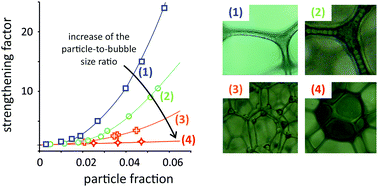Elasticity of particle-loaded liquid foams
Abstract
Mixing solid particles with liquid foam is a common process used in industry for manufacturing aerated materials. Desire for improvement of involved industrial processes and optimization of resulting foamed materials stimulates fundamental research on those complex mixtures of grains, bubbles and liquid. In this paper, we generate well-controlled particle-loaded liquid foams and we determine their elastic behavior as a function of particle size (6–3000 μm) and particle volume fraction (0–6%). We focus on both the elastic modulus exhibited by the material at small strain and the strain marking the end of the linear elastic regime. Results reveal the existence of a critical particle-to-bubble size ratio triggering a sharp transition between two well-defined regimes. For small size ratios, the behavior is governed by the mechanical properties of the solid grains, which have been proved to pack in the shape of a foam-embedded granular skeleton. In contrast, bubbles elasticity prevails in the second regime, where isolated large particles contribute only weakly to the rheological behavior of the foamed material. The modeling of elasticity for each regime allows for this transition to be normalized and compared with previously reported particle size-induced effects for foam drainage (Haffner et al. J. Colloid Interface Sci., 2015, 458, 200–208) and solid foam mechanics (Khidas et al., Compos. Sci. Technol., 2015, 119, 62–67). This highlights that rheology and the other properties of particle-loaded foams are subjected to the same size-induced morphological transition.



 Please wait while we load your content...
Please wait while we load your content...